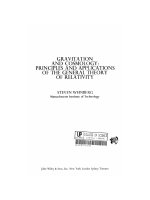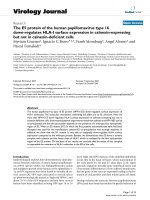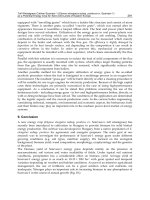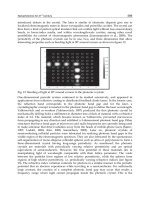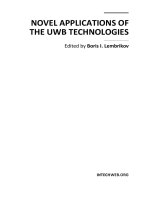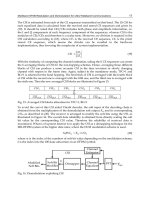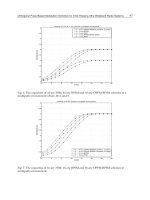Novel Applications of the UWB Technologies Part 16 docx
Bạn đang xem bản rút gọn của tài liệu. Xem và tải ngay bản đầy đủ của tài liệu tại đây (76.44 KB, 4 trang )
Novel Mechanisms for Location-Tracking Systems 15
(a) Full Centralized (b) Target Centric
Fig. 8. Illustration of two different approaches for network localization.
10
−1
10
0
10
1
10
−2
10
−1
10
0
Comparison of Different Localization Algorithms (CDF)
η =2,N
A
=4,N
T
= 8, LOS UWB-LDR Ranging model
Multi-Hop DC
Multi-Hop SQP
Multi-Hop R-GDC
Centralized R-GDC
Accuracy (in meters)
Success Rate
Fig. 9. Comparison of the localization accuracy achieved by different algorithms for the case
of a multi-hop scenario in LOS conditions.
highest accuracy. Notice, moreover, that in this simulation set up, the target-centric approach
can generally achieve a better accuracy than the centralized one. The reason is that in the
target-centric approach minimizes the impact of wrong measurements and poor connectivity
onto the localization error since, the problem to be solved is always a "single-hop" type
positioning.
437
Novel Mechanisms for Location-Tracking Systems
16 Will-be-set-by-IN-TECH
10
−1
10
0
10
1
10
−2
10
−1
10
0
Comparison of Different Localization Algorithms (CDF)
η =2,N
A
=4,N
T
= 8, Mixed UWB-LDR Ranging model
Multi-Hop DC
Multi-Hop SQP
Multi-Hop R-GDC
Centralized R-GDC
Accuracy (in meters)
Success Rate
Fig. 10. Comparison of the localization accuracy achieved by different algorithms for the case
of a multi-hop scenario in mixed LOS/NLOS conditions.
4. Conclusions
In this chapter, we have seen the most effective optimization-based localization methods
described in the literature. We distinguished them in methods for large-scale and single-hop
networks. We also addressed the NLOS problem and, we provided effective solutions for the
single-hop scenario. In the simulation section, we also described a novel approach for network
localization in NLOS conditions, which basically relies on a combination of a multi-hop
routing with a single-hop localization method.
It was observed that such a technique can provide accurate location estimates, especially in
the case of mixed LOS/NLOS conditions.
5. References
Abramowitz, M. & Stegun, I. A. (1965). Handbook of Mathematical Functions with Formulas,
Graphs, and Mathematical Tables, 10 edn, Dover Publications.
Biswas, P., Liang, T C., Toh, K C. & Wang, T C. (2006). Semidefinite programming based
algorithms for sensor network localization with noisy distance measurements, ACM
Transactions on Sensor Networks 2(2): 188–220.
Biswas, P., Liang, T C., Toh, K C., Wang, T C. & Ye, Y. (2006). Semidefinite programming
approaches for sensor network localization with noisy distance measurements, IEEE
Tansactions on Automation Science and Engineering 3(4): 360–371.
Boyd, S. & Vandenberghe, L. (2004). Convex Optimization, Cambridge University Press.
Costa, J. A., Patwari, N. & Hero, A. O. (2006). Distributed multidimensional scaling with
adaptive weighting for node localization in sensor networks, ACM Journal on Sensor
Networks 2(1): 39–64.
Cox, T. F. & Cox, M. A. A. (2000). Multidimensional Scaling, 2 edn, Chapman & Hall/CRC.
438
Novel Applications of the UWB Technologies
Novel Mechanisms for Location-Tracking Systems 17
Dardari, D., Chong, C. & Win, M. Z. (2008.). Threshold-based time-of-arrival
estimators in UWB dense multipath channels, IEEE Transactions on Communications
56(8): 1366–1378.
Dattorro, J. (2005). Convex Optimization and Euclidean Distance Geometry, Meboo Publishing.
Denis, B. & Daniele, N. (2004). NLOS ranging error mitigation in a distributed positioning
algorithm for indoor UWB ad-hoc networks, Proc. IEEE Intern. Workshop on Wireless
Ad-Hoc Netw., pp. 356–360.
Denis, B., He, L. & Ouvry, L. (2007). A flexible distributed maximum log-likelihood scheme
for UWB indoor positioning, Proc. IEEE 4th Workshop on Positioning, Navigation and
Communication, pp. 77–86.
Destino, G. & Abreu, G. (2009a). Advanced location-tracking systems in home,
automotive and public transportation environments, IEEE Personal Indoor Mobile
Radio Communication, pp. 1908 – 1912.
Destino, G. & Abreu, G. (2009b). Reformulating the least-square source localization problem
with contracted distances, Proc. IEEE 43th Asilomar Conference on Signals, Systems and
Computers.
Destino, G. & Abreu, G. (2009c). Solving the source localization prolem via global distance
continuation, Proc. IEEE International Conference on Communcations.
Destino, G. & G., A. (2009). Weighing strategy for network localization under scarce ranging
information, IEEE Transactions on Wireless Communications 8(7): 3668 – 3678.
Destino, G. & G., A. (2010). Improving source localization in NLOS conditions via ranging
contraction, IEEE Workshop on Positioning, Navigation and Communication, pp. 56 – 61.
Destino, G., Macagnano, D., de Abreu, G. T. F., Denis, B. & Ouvry, L. (2007). Localization and
tracking for LDR-UWB systems, Proc. IST Mobile & Wireless Communications Summit.
Ding, Y., Krislock, N., Qian, J. & Wolkowicz, H. (2008). Sensor network localization, euclidean
distance matrix completions, and graph realization, Proc. ACM 1st International
workshop on Mobile entity localization and tracking in GPS-less environments.
Gentile, C. & Kik, A. (2006). An evaluation of ultra wideband technology for indoor ranging,
Proc. IEEE Global Telecommunications Conference (GLOBECOM), pp. 1–6.
Gezici, S. (2008). A survey on wireless position estimation, Wireless Personal Communications
44(3): 263–282.
Gezici, S., Tian, Z., Giannakis, G., Kobayashi, H., Molisch, A., Poor, H. & Sahinoglu, Z.
(2005). Localization via ultra-wideband radios: a look at positioning aspects for
future sensor networks, IEEE Signal Processing Magazine 22(4): 70–84.
Guvenc, I., Chia-Chin, C. & Watanabe, F. (2007). NLOS identification and mitigation for UWB
localization systems, Proc. IEEE Wireless Comm. and Netw. Conf. (WCNC), pp. 1571 –
1576.
Hightower, J. & Borriello, G. (2001). Location systems for ubiquitous computing, IEEE
Computer 34(8): 57 – 66.
Joon-Yong, L. & Scholtz, R. (2002). Ranging in a dense multipath environment using an UWB
radio link., IEEE Journal on Selected Areas in Communications 20: 1667–1683.
Mao, G., Fidan, B. & Anderson, B. D. O. (2007). Wireless sensor network localization
techniques, Computer Networks: The Intern. J. of Comp. and Telecomm. Networking
51(10): 2529–2553.
More, J. & Wu, Z. (1997). Global continuation for distance geometry problems, SIAM Journal
on Optimization 7: 814–836.
439
Novel Mechanisms for Location-Tracking Systems
18 Will-be-set-by-IN-TECH
Nocedal, J. & Wright, S. (2006). Numerical Optimization, Springer.
Patwari, N., Dea, R. J. O. & Wang, Y. (2003). Relative location estimation in wireless sensor
networks, IEEE Transactions on Signal Processing 51(8): 2137–2148.
Poslad, S. (2009). Ubiquitous Computing: Smart Devices, Environments and Interactions,
978-0-470-03560-3, Wiley.
Schoenberg, I. J. (1935). Remarks to Maurice Frechet’s article “Sur la definition axiomatique
d’une classe d’espace distances vectoriellement applicable sur l’espace de Hilbert,
The Annals of Mathematics 36(3): 724–732.
Scott, K. & Benlamri, R. (2010). Context-aware services for smart learning spaces, IEEE
Transactions on Learning Technologies, 3(3): 214–227.
So, A. M C. & Ye, Y. (2005). Theory of semidefinite programming for sensor network
localization, Proc. ACM-SIAM 16th Annual Symposium on Discrete Algorithms, pp. 405
– 414.
Venkatesh, S. & Buehrer, R. M. (2007). NLOS mitigation using linear programming in
ultrawideband location-aware networks, IEEE Trans. Veh. Technol. 56(5, Part 2): 3182
– 3198.
Vossiek, M., Wiebking, L., Gulden, P., Wieghardt, J., Hoffmann, C. & Heide, P. (2003). Wireless
local positioning, IEEE Microwave Magazine 4(4): 77 – 86.
Wymeersch, H., Lien, J. & Win, M. (2009). Cooperative localization in wireless networks, IEEE
Proceedings 97(2): 427–450.
Yihong, Q., Suda, H. & Kobayashi, H. (2004). On time-of-arrival positioning in a multipath
environment, Proc. IEEE 60th Vehicular Technology Conference (VTC’04 Fall), Vol. 5,
pp. 3540– 3544.
Yu, K. & Jay Guo, Y. (2008). Improved positioning algorithms for nonline-of-sight
environments, IEEE Trans. Veh. Technol. 57(4): 2342–2353.
440
Novel Applications of the UWB Technologies


